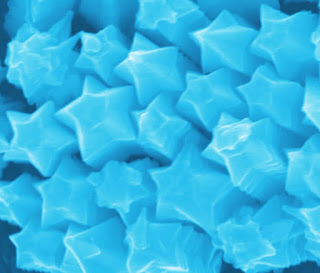HOUSTON — (March 26, 2012) — They look like fruit, and indeed the nanoscale stars of new research at Rice University have tasty implications for medical imaging and chemical sensing.
Starfruit-shaped gold nanorods synthesized by chemist Eugene Zubarev and Leonid Vigderman, a graduate student in his lab at Rice’s BioScience Research Collaborative, could nourish applications that rely on surface-enhanced Raman spectroscopy (SERS).
The research appeared online this month in the American Chemical Society journal Langmuir.
The researchers found their particles returned signals 25 times stronger than similar nanorods with smooth surfaces. That may ultimately make it possible to detect very small amounts of such organic molecules as DNA and biomarkers, found in bodily fluids, for particular diseases.
“There’s a great deal of interest in sensing applications,” said Zubarev, an associate professor of chemistry. “SERS takes advantage of the ability of gold to enhance electromagnetic fields locally. Fields will concentrate at specific defects, like the sharp edges of our nanostarfruits, and that could help detect the presence of organic molecules at very low concentration.”
SERS can detect organic molecules by themselves, but the presence of a gold surface greatly enhances the effect, Zubarev said. “If we take the spectrum of organic molecules in solution and compare it to when they are adsorbed on a gold particle, the difference can be millions of times,” he said. The potential to further boost that stronger signal by a factor of 25 is significant, he said.
The researchers tried replacing silver with other metal ions such as copper, mercury, iron and nickel. All produced relatively smooth nanorods. “Unlike silver, none of these four metals form insoluble bromides, and that may explain why the amplification is highly uniform and leads to particles with smooth surfaces,” he said.
The researchers also grew longer nanowires that, along with their optical advantages, may have unique electronic properties. Ongoing experiments with Stephan Link, an assistant professor of chemistry and chemical and biomolecular engineering, will help characterize the starfruit nanowires’ ability to transmit a plasmonic signal. That could be useful for waveguides and other optoelectronic devices.
But the primary area of interest in Zubarev’s lab is biological. “If we can modify the surface roughness such that biological molecules of interest will adsorb selectively on the surface of our rugged nanorods, then we can start looking at very low concentrations of DNA or cancer biomarkers. There are many cancers where the diagnostics depend on the lowest concentration of the biomarker that can be detected.”
The National Science Foundation and Welch Foundation supported the research.
-30- +sookie tex
Contact: David Ruth david@rice.edu 713-348-6327 Rice University Mike Williams 713-348-6728 mikewilliams@rice.edu













No comments:
Post a Comment